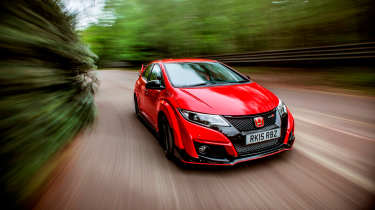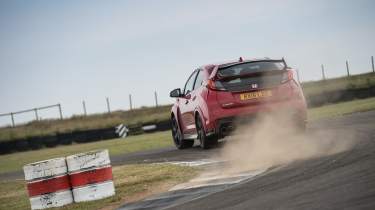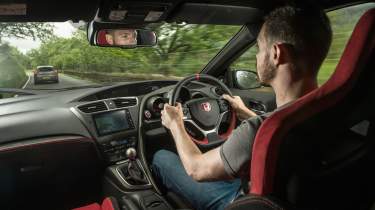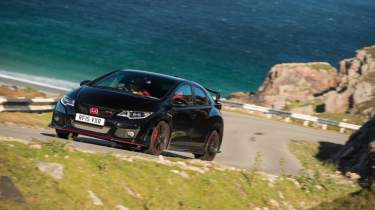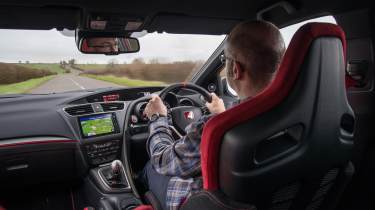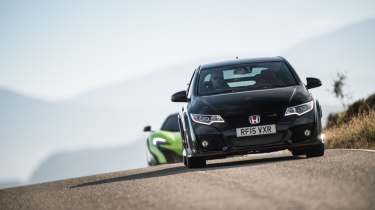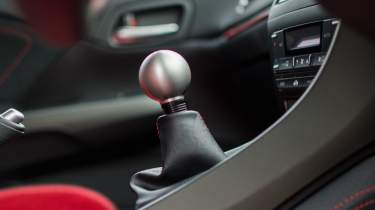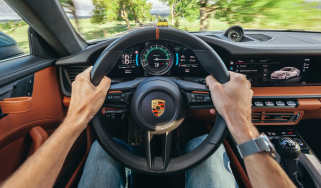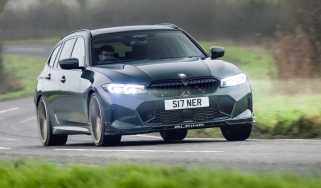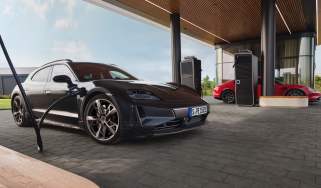Used Honda Civic Type R (FK2, 2015 - 2017) – the forgotten hardcore Focus RS rival
Honda’s first turbo Type R was hardcore and uncompromising, but deeply satisfying when the stars aligned
The anticipation of the reappearance of the Honda Civic Type R for 2016 was palpable, comparable to that of the Toyota Supra and Land Rover Defender. A hot hatch market (see Mk7 VW Golf GTI, Renault Sport Megane and Ford Focus ST and RS) without it just felt incomplete. When it did arrive, though, it was in ways a Civic Type R as they always were – rabid, taut, focused – and in others, very much not.
One of the finest manual gearshifts available at any price remained a Type R staple but the four-cylinder VTEC engine had changed beyond recognition, growing a turbocharger and barrel chest and losing almost 2000rpm in headroom to the redline. This was also a bigger, more tech-laden, family-friendly Civic Type R. All told, we were right to question its place in the lineage and enormously relieved when in the end, in part at least, the FK2 very much earned it. But it wasn’t perfect by any stretch.
Honda Civic Type R (FK2) review
Expectations and fears in equal measure surrounded Honda’s first VTEC turbo motor in a hot hatch, the K20C. Honda’s legacy of outstandingly rev-happy engines loomed large, even if their relative dearth of mid-range torque created nearly as many critics as it did fans.
More reviews
In terms of performance, the 306bhp FK2 Type R went straight to the top of the front-wheel drive hot hatch class, even outstripping the potent all-wheel drive 297bhp MK7 Golf R. With 295lb ft of torque from 2500-4500rpm, it had a veritable barrel chest by comparison to its peaky 142lb ft naturally aspirated FN2 predecessor. The Type-R managed an impressive 0-62mph sprint time of just 5.7sec, with the car topping out at 167mph. The FK2 Type-R was right at the top end of front-wheel drive cars. By comparison, the previous Type R managed 6.6sec and 146mph. Despite this impressive performance, the combined fuel consumption figure is listed as 38.7mpg and the CO2 emissions are 170g/km.
> Ford Focus ST Track Pack v Honda Civic Type R: sharpened Focus tackles the hot hatch king
Achieving all this is a 1996cc DOHC inline four-cylinder with a single, mono-scroll turbocharger and variable valve timing and lift, featuring direct fuel injection, cast alloy pistons, forged conrods and what Honda refers to as a lightweight crankshaft. Incoming air is routed through an air-air intercooler, and the compression ratio is a relatively high 9.8:1. Honda was proud of the new car’s 7,000rpm rev limit – no 8800rpm pinger but the first clue that this engine might indeed be something different from the class norm.
In practice, this is a surprisingly uncouth engine. Fire it up with a prod of the red starter button and it emits a purposeful bass-laden hum from the quad exhaust pipes, but in the cabin it’s all four-cylinder thrash and chatter. Accelerate through different rev bands and even under lighter throttle loads the engine makes its presence keenly felt with a rather tuneless blare – authentic, or irritating, depending on your mood.
This engine is happiest when worked constantly between 5000-7000rpm. You’ll cherish those extra revs at times because you can hang onto a gear even past the 6500rpm power peak and the Type R neither crashes into the limiter or runs out of puff. Aided by change up lights that grow angrier in colour and greater in number as the limit approaches, the Type R in this exact moment is an intense, engrossing experience – and seriously rapid.
A crisp, direct gearshift has always been integral to the Type R driving experience, and Honda has tried hard to not let the vastly increased torque output of the new car diminish that quality in any way. Honda at the time claimed the shift stroke of 40mm was the same as the terrific 2002 NSX-R, which certainly bodes well. Indeed, the result was a triumph, the delightful machined alloy gear knob whipping around the gate with speed and precision that shames many a rival.
As controversially reverted to in the FN2 Type R, the FK8 has a twist beam rear axle against the more sophisticated multi-link set ups of certain rivals and indeed, its EP3 grandfather. Then again, that’s not something that has ever held back the Renaultsport Megane. The FK2 added adaptive dampers and dual-axis front strut suspension to the mix. The FK2’s is a chassis that matches its engine – it’s harsh, uncompromising, magical in the right moment but cantankerous for a lot of the rest of the time, when in +R mode. Wind it back and it breathes better with the road, though you are then bereft of the engine’s sharpest levels of alertness and personality. No ‘individual ’ setting, to allow pairing of a more aggressive engine with a more compliant chassis, really held the FK2 back.
The Type R’s steering is very fast immediately off-centre, but it’s well weighted and accurate. You soon learn to slow down your inputs, particularly at high speed, where the Civic requires just a gentle nudge to alter its course. In these moments the car feels superb, with excellent stability and absolute precision. Outright grip levels on the OE 19-inch Continental tyres are predictably very high but feel and adhesion at every corner phase is vastly improved with a switch to more serious Michelins. The brakes resist fade well, and the pedal itself feels very good. Its track performance is impressive, with its 7:50.6sec Nürburgring time in period only bested by the sublime VW Golf GTI Clubsport S, which managed 7:49.21sec.
Inside, the important details carry on the Type R tradition. The gearknob is a tactile, milled alloy sphere just like it was on the previous Civic R, and is mounted only a short throw from the wheel rather than low between the seats. The seats are bewinged buckets, coated in red and black cloth, and the pedals are alloy. There are further red details on the dashboard, the gearlever gaiter stitching and on the wheel – including a modish red centre marker.
The details are great but it’s the ergonomic layout – the separation of analogue and digital dials – that remains an acquired taste. The spacing between the brake and throttle pedal is vast, too. It requires a very deliberate rotation of the ankle to perform a heel and toe downshift. A slightly wider or reshaped throttle pedal could easily solve this.
From its deeply divisive styling to its intense personality, the FK2 Civic Type R is a complex beast. But a shy and retiring Type R return would have satisfied precisely no one, so while it wasn’t received with open arms at the time, we remember the FK2 Civic Type R with fondness. Especially knowing what a proper set of tyres can do for it.
What we said
‘We’ve long thought that a naturally aspirated engine would be the enduring hallmark of a Type R, but this new Civic confirms that it’s actually a short, mechanical gearshift action. Renaultsport has had things its own way in the hot hatch market for some time, but on the evidence of this first drive, the new Type R could be the French outfit’s most credible challenger.
'Honda’s hand has been forced towards turbocharging and away from the peaky, effervescent power delivery that made the red ‘H’ badge famous. But while some will mourn the loss of the high-revving engines, the more progressive should instead celebrate the most complete Civic Type R yet.’ – Dan Prosser, – evo 211, June 2015.
Specs
| Civic Type R FK2 | |
|---|---|
| Engine | In-line 4-cyl, 1996cc, turbocharged |
| Power | 306bhp @ 6500rpm |
| Torque | 295lb ft @ 2500-4500rpm |
| Weight | 1378kg (226bhp/ton) |
| 0-62mph | 5.7sec |
| Top speed | 167mph |
| Price new | £29,995 (2015) |
| Price now | From £16,000 |
13,000 miles in an FK2 Honda Civic Type R
'If ever a long-term test car has demonstrated the value of long-term tests, our FK2 Honda Civic Type R was it. When it joined the Fast Fleet in January 2016, I had no idea how this latest Type R would fare as a long-term proposition.
'After nine months and 13,000 miles, I was totally hooked on the Type R. With every passing mile (and corner) my admiration had grown. And I wasn’t alone. Several other members of the evo team who had started out a little lukewarm about the hot Honda came back from another session in its driver’s seat declaring a developing appreciation for it. It wasn’t uncommon to hear the words ‘prefer it to the Focus RS’.
'Some at evo weren’t fans of the Civic’s styling, specifically its excess of conspicuous aero addenda. Personally, I liked it – even that rear wing. Rather than blending in with all the lesser hatchbacks on the road, here was a hot hatch that wasn’t afraid to shout about being a hot hatch. The Honda’s interior was hardly conventional either, the dual-layer dash instruments being refreshingly different from the norm but also making perfect sense. Less likeable was the double-DIN stereo/satnav unit, which was just a bit clunky compared with the best systems out there, and consistently failed to show any traffic information despite promising it was receiving it loud and clear.
'The highlight of the cabin, though, was the front seats. Snug and super-supportive, they were proof that a great seat doesn’t have to have ‘Recaro’ stitched into it. They also set the tone perfectly for the way the Type R drove. The ride could jiggle and shake passengers to the point of discomfort, but it felt brilliantly purposeful to a solo driver in the mood. In fact, it would put you in the mood, preventing you slipping into autopilot and encouraging you to drive with enthusiasm at every opportunity. Sure, on some rougher roads the damping did prove too firm – and this was in the default suspension setting – but the payback in control everywhere else was worth it. The Type R felt at home on track, too, where the super-stiff +R mode made complete sense.'
'Matching this hardcore chassis was a turbocharged 2-litre engine producing 306bhp. This turbocharging of a Type R was somewhat controversial when the model was launched, but the absence of naturally aspirated purity and a ‘VTEC rush’ never crossed my mind thanks to the scale of the performance on offer. Equipped with super-sticky Michelin Pilot Sport Cup 2 tyres (not offered by Honda, but an upgrade I can’t recommend enough) it lapped the West Circuit in exactly the same time as an identically shod Focus RS – a car with an extra 39bhp and four-wheel drive, remember.
'Super-sticky Michelin Pilot Sport Cup 2 tyres (not standard but an upgrade I can't recommend enough) replaced the original Continental SportContact 6s at around 6500 miles. So equipped, it lapped the West Circuit in exactly the same time as an identically shod Focus RS – a car with an extra 39bhp and four-wheel drive, remember.
'The rate at which you’ll get through consumables is clearly something to bear in mind with this new breed of 300bhp-plus hatchbacks: at the Civic’s first service – requested by the car at 10,891 miles and costing £195 – we were told that the front pads and discs were already 80 per cent worn. Gulp. Other signs of wear were few. Some plastics in the cabin, such as the roller shutter over the cupholders, seemed to scuff a little too easily, and while the unusually tall seat-base bolsters were brilliant when you were driving, they were impossible to avoid when getting into or out of the car, so the fabric on top of the outer driver’s side example was starting to look a little flattened and creased. But otherwise the Civic felt rock-solid, with not a single creak or rattle from the cabin – always a concern with hard-riding cars.
'If you want a hot hatch that’s involving, exciting, hardcore, individual, head-turning and never, ever boring, then you won’t regret it.' – Ian Eveleigh, evo 229, December 2016.
What to pay and buying guide
On road and track, only the most extreme of contemporary rivals best the FK2 Civic Type R. Cars like the VW Golf GTI Clubsport S and the Renault Sport Megane 275 Trophy-R, though the Focus RS and Seat Leon Cupra Sub8 both ran it close. What a great time for hot hatches the mid-2010s was…
The Honda Civic Type R started at £30,000 on the dot when new and was only available for a couple of years before the FK8 took its place. As a consequence, FK2s are rarer and have held money reasonably well. Prices between £15k and £20k depending on condition and miles are strong for a car that’s approaching a decade old.
The majority of buyers opted for the GT pack, which added satellite navigation, adaptive cruise control and various safety systems over and above the large equipment roster in the standard car. It won’t affect the way the car drives but might make it more pleasant to live with day to day.
Rare though it is, the FK2 Type R is still, well, a Type R. So it will have been bought for the most part by enthusiast drivers, likely driven hard and hopefully, maintained to a high standard. The reliability record of these cars, as you’d hope for a Honda, is strong. But that doesn’t mean you shouldn’t maximise your chances of trouble-free motoring by choosing an example with documented maintenance history, across services and MOTs.
